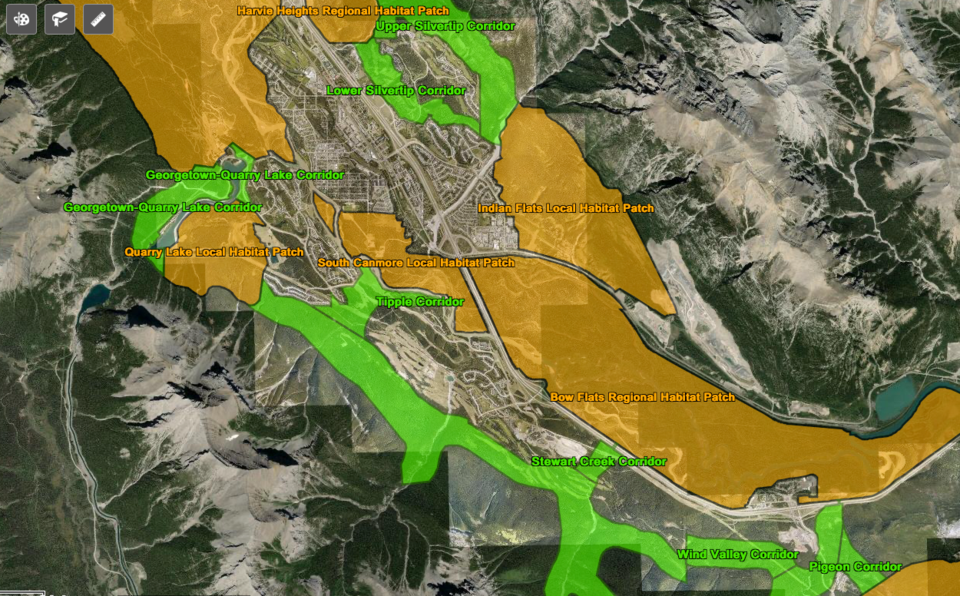CANMORE – The Yellowstone to Yukon Conservation Initiative has set out to undertake a future scenarios cumulative effect modelling project to better understand human wildlife coexistence in the Bow Valley.
Y2Y Alberta program manager Adam Linnard said the work will look at the region – from Castle junction to the Kananaskis River – by using the best available data, approved development plans, and wildlife studies to anticipate a number of future scenarios for wildlife movement.
"For the past year or so, Y2Y has been exploring the possibility of forming an advisory group to inform this work," Linnard said in a presentation to Canmore council May 19. "We have been working with the goal of [establishing] an advisory group made up of valley jurisdictions ... following the human-wildlife coexistence group's example."
The human-wildlife coexistence group was formed in 2018, a year after grizzly bear No. 148 faced challenges travelling up and down the Bow Valley and its fractured jurisdictions. The female grizzly was relocated from Canmore by Fish and Wildlife, but subsequently wandered into B.C. and was legally killed by a trophy hunter before that province banned the practice.
Between Canmore and Banff, there are three government agencies responsible for wildlife – Parks Canada, Alberta Parks and Fish and Wildlife – each of which has its own set of policies and procedures.
Grizzly bear movement, said Linnard, is an important indicator that can be affected by different development scenarios on the landscape. They are also a keystone species, meaning healthy populations of grizzly bears is an indicator of the overall health of an ecosystem. Linnard said that is why the modelling proposed would focus on that species to gain a better understanding of the effects of development on wildlife movement throughout the region.
The agencies that Y2Y would like to form the advisory group include all three municipalities in the valley, as well as wildlife management agencies. Linnard said the Town of Canmore's involvement would inform the development of future scenarios and ensure they are as accurate as possible, with a final report expected in 2021.
"This is not a suite of recommendations," he said. "This is a suite of information to inform land-use planning within the valley.
"We would like council to consider directing a small amount of staff time to the advisory group to make sure this modelling is as valuable to the Town of Canmore as possible."
The work is being done by ALCES Group, an inter-disciplinary team of scientists and software developers that aim to provide an understanding of the effects of human activity on the environment and society. The group has an online tool that simulates environmental and socioeconomic consequences of land use over space and time.
Matt Carlson, an ecologist with ALCES Group, said the intent is to asses the cumulative effect of land-use footprints and human use on wildlife connectivity in the Bow Valley with a focus on grizzly bears.
"In addition to assessing the effect of past, current and future potential land use on grizzly bears' connectivity, the intent is to explore the effectiveness of mitigation strategies that would be identified by the advisory committee," Carlson said. "The objective is to inform strategic planning in support of human wildlife coexistence."
For Y2Y, being able to predict the effect of a range of land use decisions and human activity on the landscape is a valuable tool to have access to for council and the community.
"This has been referred to as the tyranny of small decisions and is responsible for many of the environmental problems we have today," Carlson said. "It really requires a consideration of larger spatial and temporal scales."
He said the human footprint of Canmore has increased five fold over the last 50 years and it is important to understand the effects those decisions have had, especially when it comes to the functionality of wildlife corridors.
Carlson said the tool could also be used to evaluate the socioeconomic values affected by different development scenarios in the community. He said outcomes from this type of analysis can be very informative for decision makers and the community in general.
Mayor John Borrowman expressed frustration that despite setting aside significant portions of land to designate as wildlife corridors to improve connectivity, human use inside them continues and decreases their effectiveness. He said the tool must consider actual human use of the landscape in addition to land use decisions.
"It does not matter how effective a corridor is designed if humans choose to ignore or disregard its intent," said the mayor. "I see these two things going hand-in-hand. We have to design really high functioning corridors, but we also have to make sure the people who live here accept the intent and honour it."
Linnard spoke to the importance of grizzly bear movement in the Bow Valley in general. This specific geographic region is one of two valleys in the Rocky Mountains that stretch from the Yukon to Yellowstone National Park in the U.S. that provides east-west movement for wildlife. Movement of wildlife throughout the region allows the genetic information of a species survive and supports healthy populations on the wider landscape.
Linnard said the work being proposed would help council and the community understand possible future scenarios for wildlife movement in the valley.
"It is a matter of showing the range of likely outcomes for a range of likely scenarios," he said.
The request for staff support from administration will return to council in the future for elected officials to decide if they will participate in the project with Y2Y and ALCES Group.




